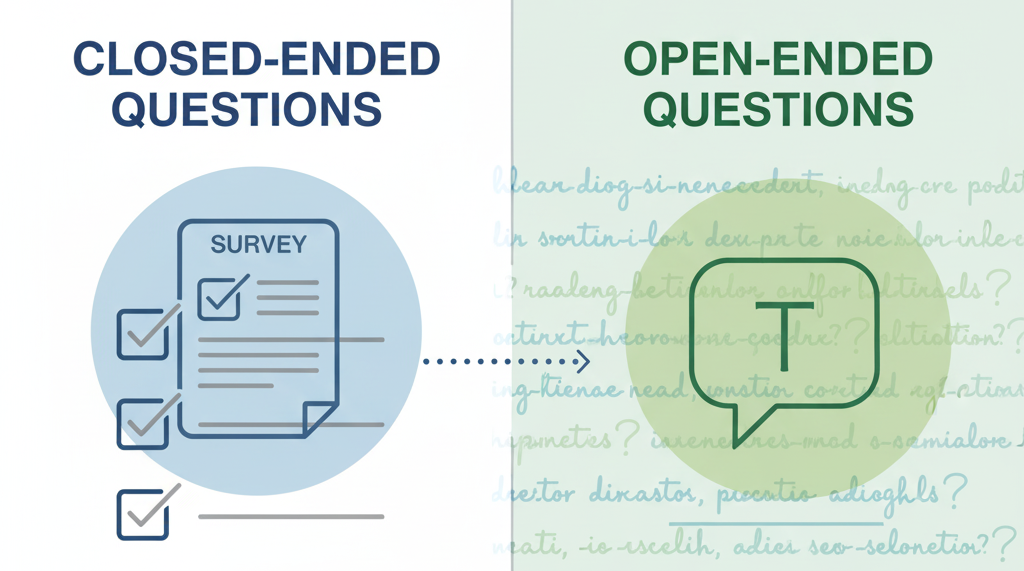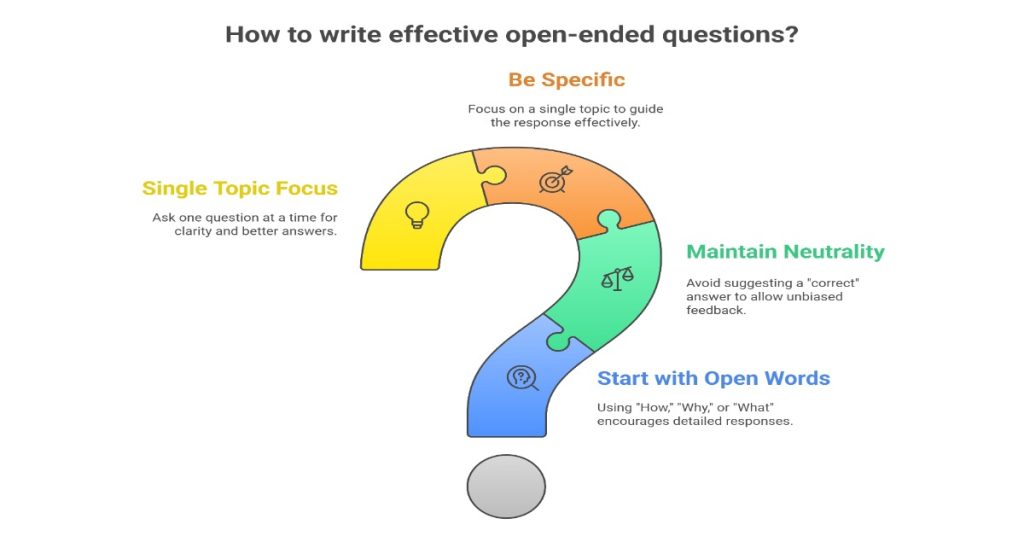Are you tired of sending out surveys only to get back a series of checkboxes and ratings that don’t really tell you anything? You see that 75% of users are “satisfied,” but you have no idea why. You know what they did, but not what they were thinking. This is a common frustration for anyone trying to gather meaningful feedback. You are putting in the effort to create and distribute questionnaires, but the data you get back is flat and doesn’t lead to real improvements.
The solution is simpler than you might think: asking open-ended questions. These questions invite people to share their thoughts in their own words, giving you rich, detailed insights that multiple-choice questions simply can’t provide. This guide will show you how to write effective open-ended questions, where to place them in your surveys, and how to make sense of the valuable answers you receive.
Table of Contents
What’s the Difference Between Open and Closed Questions?
First, let’s quickly clarify the basics. Most surveys are filled with closed-ended questions. These are questions that can be answered with a simple, predefined response.
- Closed-ended questions include: Yes/No questions, multiple-choice questions, and rating scales (e.g., “Rate your experience from 1 to 5”).
They are great for gathering quantitative data—the “what.” They are easy for people to answer and simple for you to analyze. You can quickly turn the results into charts and percentages.
- Open-ended questions, on the other hand, ask for a descriptive answer. They can’t be answered with a simple “yes” or “no.” Think of them as conversation starters.
Examples include questions that start with “Why,” “How,” or “What are your thoughts on…” These questions give you qualitative data—the “why” behind the “what.” They reveal the stories, opinions, and feelings of your audience.

The Problem with Only Using Closed-Ended Questions
If you rely only on closed-ended questions, you are operating with blind spots. The biggest issue is that you are limiting your respondents to the answers you have already thought of. This means you might be making assumptions about what is important to them, and you could be missing out on critical information.
Imagine you run an e-commerce website and you ask, “What was the most important factor in your purchase? A) Price, B) Shipping Speed, C) Product Selection.” You might find that “Price” is the top answer. But what if the real reason a customer loved their experience was the helpfulness of your customer support chat, and that wasn’t an option? You would never know. By not providing a space for an open response, you miss the chance to discover what truly matters to your customers. This is how you miss out on unexpected ideas and important feedback that could guide your business strategy.
How to Write Good Open-Ended Questions?
Writing an effective open-ended question is part art, part science. The goal is to encourage a thoughtful response without guiding the person to a specific answer. Here are some practical tips.
- Start with “How,” “Why,” or “What.” These words naturally invite a more detailed explanation. For instance, instead of asking “Are you satisfied with our service?” (a closed question), ask, “What is one thing we could do to improve our service?”
- Keep them neutral and unbiased. Your questions should not suggest a “correct” answer. For example, avoid asking, “What did you love about our new feature?” This question presumes they loved it. A better, more neutral question would be, “What are your thoughts on our new feature?” This allows for both positive and negative feedback.
- Be specific enough to guide the response. A question like “Do you have any feedback?” is too broad and can be intimidating. A more specific question like, “What was the most confusing part of our checkout process?” will give you more focused and useful information.
- Focus on a single topic per question. Avoid asking two things at once. For example, don’t ask, “How did you find the user interface and what did you think of the customer support?” Break it into two separate questions to get clearer answers for each topic.

Where to Put Open-Ended Questions in Your Questionnaire?
The placement of your open-ended questions can greatly affect the quality of the responses you get. If you put too many at the beginning, people might feel overwhelmed and abandon the survey.
A good strategy is to use them to dig deeper into a previous response.
- Start with easy closed-ended questions. Begin your survey with simple multiple-choice or rating questions. This warms up the respondent and gets them engaged without demanding too much effort upfront.
- Follow up a closed question with an open one. This is a powerful technique. First, ask for a rating, then ask for the reason behind it. For example:
- Question 1: “On a scale of 1-10, how likely are you to recommend our product to a friend?” (Closed)
- Question 2: “What is the main reason for the score you gave?” (Open)
This gives you both a quantitative score and the qualitative story that explains it.
- Question 1: “On a scale of 1-10, how likely are you to recommend our product to a friend?” (Closed)
- Don’t overdo it. Open-ended questions require more mental effort. A survey with too many of them can lead to “survey fatigue,” where people either quit or give low-effort, one-word answers. For most surveys, two to three well-placed open-ended questions are enough.
- End with a catch-all question. A great way to conclude a survey is with a final, optional open-ended question like, “Is there anything else you would like to share with us?” This can be a goldmine for surprising insights, brilliant ideas, or important complaints that your other questions didn’t cover.
Making Sense of the Answers
This is often the part that makes people hesitant to use open-ended questions. How do you analyze hundreds of different text responses? It might seem difficult, but you don’t need to be a data scientist to find valuable information.

The key is to look for themes and patterns. Here’s a simple process you can follow:
- Read through the responses. First, just read a sample of the answers to get a general feel for what people are saying.
- Start grouping similar comments. Create a few broad categories. For example, if you asked for feedback on a software product, your categories might be “Bug Reports,” “Feature Requests,” “Usability Issues,” and “Positive Comments.”
- Tally the themes. As you read through each response, make a mark next to the category it falls into. You might find that a single response touches on multiple themes. That’s okay.
- Identify the most common themes. After you have gone through all the responses, you will clearly see which topics are coming up most frequently. If 40% of comments mention that your website is slow to load, you have identified a clear priority for your development team.
This manual process works well for up to a few hundred responses. For larger datasets, you can use tools like word clouds to visually see which words are most frequent or use spreadsheet functions to search for keywords.
Read More
The Role of Random Sampling in Ensuring Survey Accuracy Online
Targeting the Right Audience: Strategies for Demographics in Online Surveys
Tired of Empty Surveys? Key Strategies for Getting More People to Finish Yours
It’s Time to Start the Conversation
Closed-ended questions give you the skeleton of your data, but open-ended questions provide the substance. They turn faceless data points into human stories, giving you the context and deep understanding needed to make smart decisions. The fear of getting messy data or not knowing how to analyze it prevents many people from asking these powerful questions.
Don’t let that be you. Start small. Add just one or two well-crafted open-ended questions to your next questionnaire. You’ll be surprised by the quality of the feedback you receive and how much clearer your path to improvement becomes.

